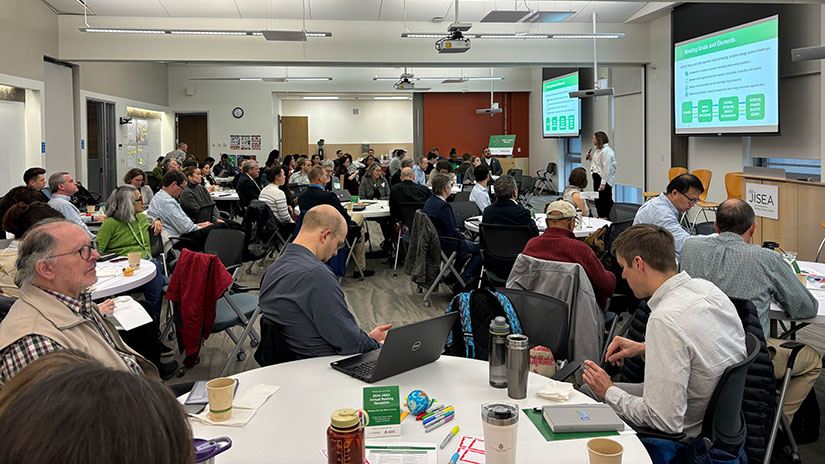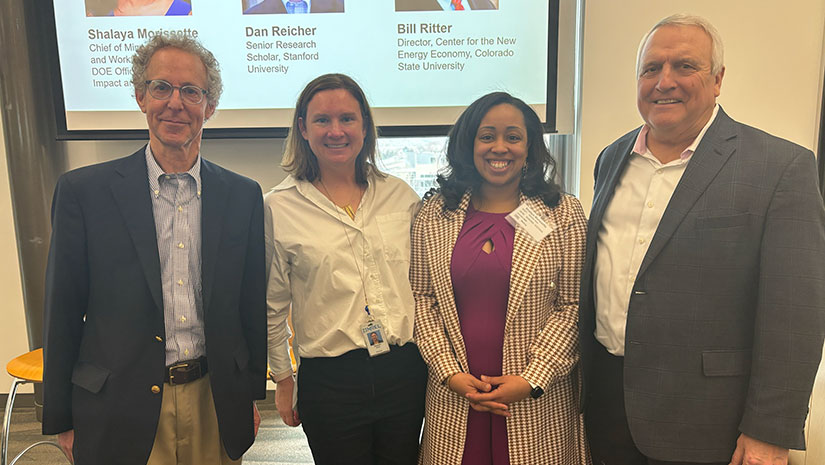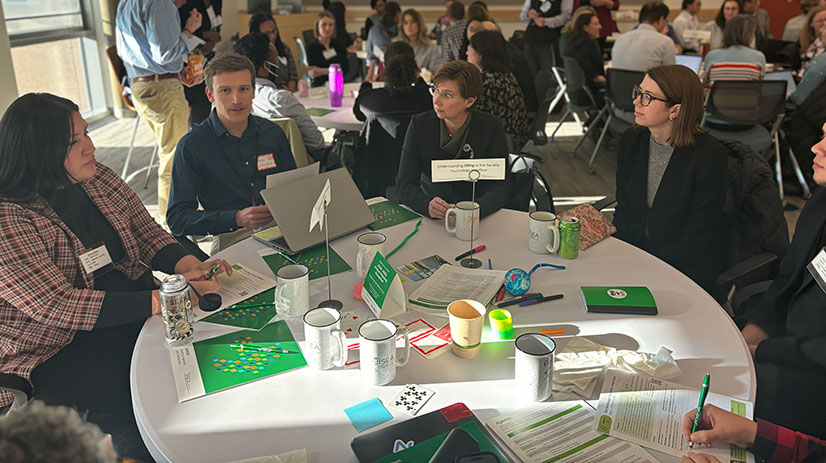2024 JISEA Annual Meeting Convenes Clean Energy Voices To Address Emerging Challenges
Crosscutting Event Brings Together Leaders From Research, Industry, Universities, and Nonprofits

Attendees gather at the 2024 JISEA Annual Meeting. Photo by Daniella Frank, NREL
Tackling clean energy challenges means bringing different voices to the table, and that is exactly what happened at the 2024 JISEA Annual Meeting (JAM24). The Joint Institute for Strategic Energy Analysis (JISEA) convened more than 120 clean energy leaders from across research, industry, universities, and nonprofits for its 13th annual meeting to identify emerging clean energy transition opportunities and challenges.
"This year we prioritized engaging different organizations and building discussion-based sessions to create a venue for crosscutting collaboration," JISEA Director Elizabeth Doris said.
JISEA is an institute at the U.S. Department of Energy’s (DOE’s) National Renewable Energy Laboratory (NREL) focused on building expertise and capabilities around emerging multidisciplinary clean energy challenges through network development, seed research investments, and innovative prize mechanisms. Having played a pivotal role in the early development of research domains at NREL, including supply chain resilience and agrivoltaics, the institute is now looking to the next wave of clean energy challenges and convening clean energy experts to help lead the charge.
Multidisciplinary Meeting of Minds
This year’s event was divided into four working sessions, each focused on the upcoming priorities in JISEA’s four focus areas: hard-to-decarbonize industries, technology-society interface, climate adaptation and clean energy, and workforce for the future. Participants heard from context-setting speakers and panels and then collaborated on activities organized around specific outputs, working to convert the insights from the meeting into tangible analyses that can guide future projects and partnerships. By the end of the meeting, participants had initiated the development of a database of clean energy workforce development programs across the country, gathered insights for a publication on climate adaptation, and more.
“Just as important as all these individual fields of research is being able to see the connections between them—finding opportunities to integrate them for maximum impact,” NREL Director Martin Keller said at the meeting. “This is where JISEA excels—where they have great potential to truly make a difference.”

From left: Dan Reicher, Liz Doris, Shalaya Morissette, and Bill Ritter led a lively lunch panel on the challenges and successes of the clean energy transition. Photo by Daniella Frank, NREL
In each session, discussions were led by clean energy experts from both inside and outside of NREL. In addition, featured guests Dan Reicher, former assistant secretary of energy for energy efficiency and renewable energy, and Bill Ritter, former governor of Colorado, participated in a lunch panel hosted by Shalaya Morissette, chief of the Minority Business and Workforce Division at DOE, on the challenges they have faced and the opportunities they foresee in the clean energy transition.
Emerging Themes for the Future
Though the topics at the meeting ranged from methane production from cows to artificial intelligence in clean energy, several common themes emerged. One consistent theme was the importance of place-based innovation and tactical collaboration from different practitioners at a variety of scales.

JAM24 attendees discuss the impact of siting in the adoption of clean energy technologies. Photo by Daniella Frank, NREL
The themes from the meeting were shared at the JAM24 Synthesis webinar, an annual follow-up to the annual meeting where the JISEA team reports on insights from the meeting and opportunities for further collaboration. Following the meeting, the institute is channeling these insights into its efforts, including informing the newly launched Sustainable Agriculture Catalyzer, a comprehensive workforce development study, and new partnerships with attendee organizations around shared priorities.
Preparing for the 2025 JISEA Annual Meeting
As JISEA prepares for the 2025 JISEA Annual Meeting (JAM25), the institute plans to expand the event to increase participant engagement with NREL and broaden the slate of topics covered. JAM25 will take place on Feb. 26–27, 2025, as the featured event in the first-ever JISEA Institute Week. Throughout the week, JISEA will host tours, meetings, and educational tracks to connect participants with NREL’s latest innovations.
“NREL is at the forefront of the clean energy transition, and our annual meeting attendees want to engage with the progress we are making,” Doris said. “By extending the meeting, we’re expanding the opportunity for information exchange between the laboratory and our multidisciplinary attendees.”
JISEA is collaborating with partners to develop the agenda and seeking active participants in the form of planning committee members and sponsors. If your organization is interested, reach out to Director Elizabeth Doris.
Visit the JISEA Annual Meeting webpage to view presentation slides and the recording of the JAM24 Synthesis webinar.
Note: The Joint Institute for Strategic Energy Analysis retired in February 2025. This article has been updated to reflect editorial changes made after its original publication.
Last Updated May 28, 2025
